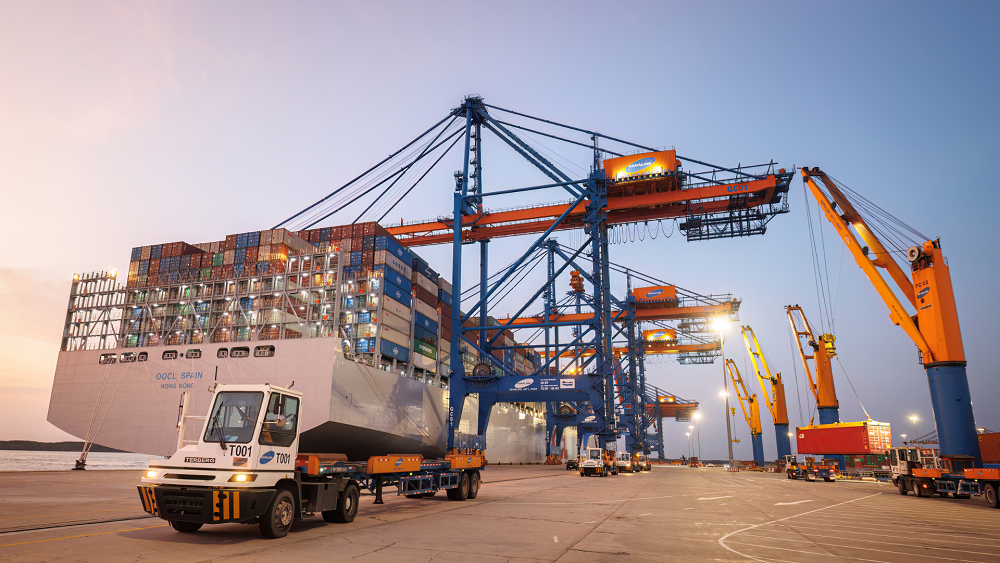Prospects for stocks in the port and marine shipping industry
Securities companies have positively evaluated the stocks of enterprises in the port and maritime transport sector such as HAH, GMD, and PVT.
HAH: Profit recovery from Q2
According to SSI Securities, in Q1/2024, Hai An Loading & Unloading Transport Joint Stock Company (HoSE: HAH) was still affected by the container transport industry's negative cycle from mid-2022 to 2023. The firm's sales increased by 7% to 704 billion VND, while the parent company shareholders' net profit declined by 57% to 51 billion VND, accounting for just 17% of the company's goal.

HAH's profit will recover from Q2/2024 compared to the previous quarter, due to favorable freight rates and recent demand growth reflected in the import and export data from April and mid-May - Image: HAH.
Aside from the contribution from the new 1,780 TEU capacity vessel launched in early 2024, a significant increase in transport volume is vital to reversing HAH's income growth trend. SSI believes this is owing to a robust rebound in China's export value, which climbed by 22% during the same time. This recovery is also evident in the Hai Phong port cluster's international transport volume, which has recovered faster than domestic transport demand.
According to SSI, despite revenue increases, the profit margin remains tight, resulting in a continuous drop in profit. Self-operated vessels proved to be less efficient, owing mostly to overstock in the local market and a slower rate increase for routes in Inner Asia compared to those immediately affected by Red Sea conflicts. Furthermore, HAH's vessel leasing division has yet to record good fixed-term rental pricing because existing low-priced contracts end in April.
Notably, the global container index, representing the spot freight rates for major international transport routes, has returned to Covid-era levels, while the fixed-term lease price for 1,700 TEU vessels has increased by 65% since the beginning of the year.
Regarding HAH's business operations, SSI believes that high freight rates over a longer period will positively affect the fixed-term vessel leasing contracts expiring from Q4/2024 onwards, as well as the spot rates on domestic routes, which have not yet recovered strongly since the beginning of 2024.
"We believe that profits will recover compared to the previous quarter from Q2/2024, due to the favorable price environment and recent demand growth reflected in the import and export data from April and mid-May," SSI evaluated.
As a result, this Securities Company has provided a positive recommendation for HAH stock. It also feels that the capacity to recover earnings and developments in the worldwide container transport business are more significant indicators to monitor (while remaining optimistic in the short run) than the present comparative value.
GMD: Increase in Container Handling Services
For Gemadept Corporation (HoSE: GMD), DSC Securities assessed the business results of Q1/2024 as recording impressive growth, with net revenue increasing by 11%, reaching 1.005 trillion VND, pre-tax profit increasing by 135%, and after-tax profit increasing by 157%.

The increase in container handling services and the opening of the Ha Nam canal will help improve the core business profit - Image: GMD.
This breakthrough was motivated by three major factors: First, increase freight throughput. Cargo traffic via GMD's port system climbed by 56%, to 908,000 TEUs, compared to the same period previous year. In the port segment, consolidated revenue climbed by 29% compared to the same time last year, owing to robust export-import growth in the first three months of the year, and GMD continued to sign with new clients, increasing capacity to receive and process cargo.
Second, the rise in handling service prices: Circular 39/2023/TT-BGTVT, which adjusted the floor price for container handling services by 10% on average, served as a catalyst for GMD's revenue and profit growth this quarter. This strategy increased income from container handling activities, particularly at deep-water ports in the Southern region, which is a major sector for GMD.
Third, the divestiture from Nam Hai Port in Q1/2024 resulted in a quick profit of about 336 billion VND for GMD, greatly increasing the company's financial revenue.
DSC believes that thanks to the sudden profit from the divestment of Nam Hai Dinh Vu Port, GMD's P/E has dropped to 9.86 times, lower than its historical level. However, excluding this profit, GMD's P/E could exceed 20 times, higher than the 5-year average of 17.90 times. Similarly, the current P/B is 2.82 times, also significantly higher than the 5-year average of 1.91 times.
Despite the positive prospects from Nam Dinh Vu 2 (NDV2) and Gemalink (GML), DSC believes that the current adjusted P/E and P/B are not truly attractive. With the assumption that NDV2 goes into operation replacing Nam Hai Dinh Vu that has just been divested reaching 80% capacity and GML significantly recovering, recording 1.4 million TEUs in 2024. DSC estimates that GMD's net revenue for 2024 is expected to reach 4.064 trillion VND, an increase of 6%, and after-tax profit will reach 1.392 trillion VND, a decrease of 45% compared to the previous year.
"We see that GMD is a leading enterprise with competitive advantages and clear long-term growth potential, therefore it can be monitored and invested when the stock price discounts to about 63-66,000 VND," DSC recommended.
PVT: Investment Activities Support Mid and Long-term Prospects
For PetroVietnam Transportation Corporation (HoSE: PVT), BSC Securities evaluated, the main highlight in the business results of Q1/2024 was thanks to two factors:
First, the core business operations recorded promising results, increasing by 68% thanks to the average freight rate maintaining a high base of 2023 and the expanded fleet. Net revenue reached 2.536 trillion VND, an increase of 26% compared to the same period, mainly led by the transport segment thanks to the addition of 7 vessels entering operation compared to the same period. Among them, the transport of crude oil and refined products/chemicals led positively with revenue recorded at 1.340 trillion VND, an increase of 37% compared to the same period.

PVT plans to invest more in the chemical vessel fleet instead of refined oil in 2024 – 2025 - Image: PVT.
Besides, the fixed-term (TC) charter rates for the crude oil and refined oil vessel group remained flat over the high base of 2023 thanks to the imbalance between supply and demand for oil vessels and increased ton-mile demand due to geopolitical conflicts. TC rates for chemical vessels did not fluctuate much thanks to relatively stable demand.
Second, positive contributions from expanding the fleet: In the short term, the new fleet added 20% capacity to the total capacity from the second half of 2023 to Q1/2024. Thanks to the benefit from the high base of 2023 charter rates, the expansion of the fleet is expected to support positive revenue growth in the transport segment, increasing by 37% compared to the same period in 2024.
In the medium and long term: PVT plans to invest more in the chemical vessel fleet instead of refined oil in 2024 – 2025. Due to the trend of transitioning in the use of fossil fuels and the market for this segment being relatively stable. BSC believes that this investment activity supports the medium and long-term prospects of the enterprise.
Therefore, in 2024, BSC projects PVT to record net revenue and after-tax profit of 12.584 trillion VND, an increase of 32%, and 1.225 trillion VND, an increase of 26% compared to the previous year, equivalent to an EPS of 3,235 VND/share. The forecast is mainly based on the following assumptions: Net revenue for 2024 is led by a 39% increase in the transport segment. Mainly thanks to the contribution of 8 new vessels purchased from the second half of 2023 and Q1/2024 helping the fleet capacity increase by 20%; Gross margin improves 1.1bsp thanks to high freight rates compensating for operating costs from new vessel investments and OPEX/vessel costs decrease as the number of vessels increases; After-tax profit grows strongly by 26% mainly from the contribution of core business operations.








